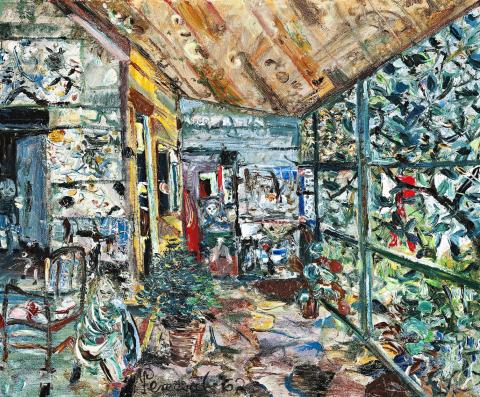THE STUDIO – CANTERBURY, 1962
JOHN PERCEVAL
oil on canvas on composition board
83.0 x 100.5 cm
signed and dated lower centre: Perceval 62
Philip Bacon Galleries, Brisbane (label attached verso)
Private collection, Perth
The Artist’s Studio, 1961, oil on canvas, 91.7 x 119.8 cm, in the Monash University Collection, Melbourne
The Studio – Canterbury, 1962 is one of the last paintings John Perceval created before moving his whole family to London for an extended period. The relocation was the culmination of a highly successful series of exhibitions by the artist featuring his celebrated paintings of the working port of Williamstown, and ceramic sculptures of wildly exuberant Angels. Further, the National Gallery of Victoria mounted a major survey in 1962 of the so-called ‘Angry Penguins’, the group of artists from the 1940s including Nolan, Tucker and Boyd, who had radically transformed the artistic landscape of Australia. Entitled Rebels and Precursors, the exhibition also included many works by Perceval, the youngest of the group, whose paintings revealed a deeply personal and humanist response to the world around him. Since 1954, the Percevals had lived in Melbourne’s eastern suburbs and The Studio – Canterbury shows the artist’s working area at the back of their house. It may be interpreted as a nostalgic farewell to familiar domesticity and is also one of a very few works painted by Perceval in that year during which he was otherwise engaged in completing a major ceramic commission for Monash University.
Tangled and rambunctious, Perceval’s studio was the complete opposite of the usual quiet, contemplative space employed by artists. Children and pets were a constant presence, as was the wild garden beyond the floor-to-ceiling glass walls. Such an atmosphere was a direct extension of the famed AMB Pottery that the artist had operated with his brother-in-law Arthur Boyd, vividly captured in such paintings as The Pottery, 1948 (Deutscher and Hackett, 4 May 2016, lot 10) where pots teetered from shelves and rafters, and children crawled under tables. The Studio – Canterbury is the companion to The Artist’s Studio, 1961 (Monash University Collection), a slightly larger painting which shows the same room from a different angle. Whereas the latter depicts the artist’s naked model wandering Eve-like in the verdant growth, the work on offer here features three of the artist’s children and their shaggy black-and-white dog, ‘a (painterly) prospect that strikes out to be joyous’.1 The room itself is painted in relatively flat passages, but the application for the garden is thick and buttery, ‘commas and squiggles of pure pigment’.2 Additional details, such as the children, are applied in sharp impasto strokes that harmonise the differing treatments of the two areas.
Awarded the Wynne Prize for Landscape Painting in 1960, Perceval’s exhibition at Australian Galleries the following year included works based on the studios of his friends Mirka Mora, Neil Douglas, and John and Sunday Reed; and The Studio – Canterbury is the conclusion to this sequence. That same year, he was also included in the ground-breaking exhibition, Recent Australian Painting, held at the Whitechapel Gallery in London. With his colleagues Charles Blackman and Arthur Boyd already living there, the time was right for Perceval to take advantage of the situation and join them. The Canterbury house was sold in January 1963 to fund the expedition and it is likely that he took The Studio – Canterbury with him, as it appears not to have been exhibited and small passages of the impasto have been flattened, evidence of being packed against other paintings whilst still slightly wet. Settling in Hampstead, the family were delighted to discover another overgrown garden next door, thus providing a new motif and logical extension for Perceval in paintings such as Deserted Garden at Hampstead Heath, c.1963 where the vegetation now totally engulfs the picture plane.
1. Plant, M., ‘Australian Modernism’, in Duncan, J. and Michael, L. (ed.), Monash University Collection: Four decades of collecting, Monash University Museum of Art, Melbourne, 2002, p. 54
2. ‘Australian Painter’s Youthful Zest’, Times, London, 12 March 1964, p. 16
ANDREW GAYNOR
